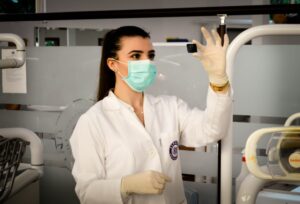The retail sector could benefit from computer vision technology by improving customer service and streamlining operations.
This is how: Retailers can use computer vision to track client purchasing patterns and make personalized product recommendations that are relevant to their interests.
Interactive displays:
Interactive displays that engage customers and improve their shopping experiences can be made using computer vision. Customer wait times can be decreased by retailers using computer vision to monitor line lengths and optimize personnel numbers.
Digital displays that enable customer interaction with goods, content, or services by touch, gesture, or voice input are referred to as interactive displays. By offering real-time monitoring and analysis of customer interactions, computer vision technology is essential in enabling interactive displays in retail.
As an illustration, computer vision-powered cameras and sensors can be used to monitor how users interact with interactive displays, collecting crucial data on user engagement, preferences, and consumer behavior.
Computer vision can also be used to deliver immersive, interactive experiences, such as augmented
reality try-ons or virtual reality product demos. Customers can receive personalized content and product recommendations from interactive displays based on their unique tastes and activity
Better supply chain management:
Retailers can use computer vision to trace product flow from the factory to the store and monitor suppliers, ensuring that the right products are available at the proper time and location.
The administration of all processes involved in the creation and distribution of goods is referred to as supply chain management. The use of computer vision technology to provide real-time monitoring and analysis of the production, transportation, and delivery processes has the potential to greatly improve supply chain management in retail.
Retailers may easily spot bottlenecks and streamline their processes by using computer vision-powered cameras and sensors to follow the movement of goods inside a warehouse, for instance. The distribution of items from suppliers to retailers can also be tracked and seen using computer vision, giving the entire supply chain real-time visibility and lowering the risk of missing or damaged goods.
Additionally, production processes can be observed and analyzed using computer vision.
Improved data analysis:
Computer vision can give merchants a plethora of information about their consumers and operations, empowering them to decide wisely and run their businesses more profitably.
The term “improved data analysis” refers to the application of cutting-edge methods, instruments, and algorithms to the extraction from data of significant patterns and insights that improve decision-making and results. Big data technology, machine learning, statistical analysis, and data visualization are all included in this. Making data-driven decisions and gaining a competitive edge through the identification of new opportunities, process optimization, and risk mitigation are the aims of improved data analysis.
Enhanced security:
Retailers can employ computer vision to keep an eye on store cameras and spot security risks, cutting down on the likelihood of mishaps and injuries.
Measures made to better safeguard sensitive data, systems, and assets from unauthorized access, use, disclosure, interruption, alteration, or destruction are referred to as enhanced security.
This includes utilizing cutting-edge tools like firewalls, intrusion detection systems, encryption, and identity and access management systems. Strong security policies and processes, regular security assessments and risk management, as well as giving personnel security awareness training are all part of it.
Enhancing security is to reduce the risk of security lapses and cyberattacks while ensuring the confidentiality, integrity, and availability of crucial data and systems.
Better marketing:
Retailers can track client preferences and decide on marketing campaigns using computer vision, which will help them be more successful.
These are just a few examples of how computer vision technology is revolutionizing the retail sector, enabling businesses to improve consumer experiences, optimize processes, and stay competitive in a quickly shifting environment.
Better marketing refers to the use of methods and techniques for reaching and interacting with target audiences, fostering brand recognition and loyalty, and generating leads and sales for businesses. This covers both traditional marketing approaches like events, advertising, and public relations as well as digital marketing strategies like search engine optimization, social media marketing, email marketing, and content marketing.
Increased customer acquisition and retention, enhanced brand recognition and reputation, and business growth are the objectives of improved marketing. A thorough grasp of the target market, market trends, and competition is necessary for effective marketing, which also calls for ongoing measurement and optimization of marketing efforts.









